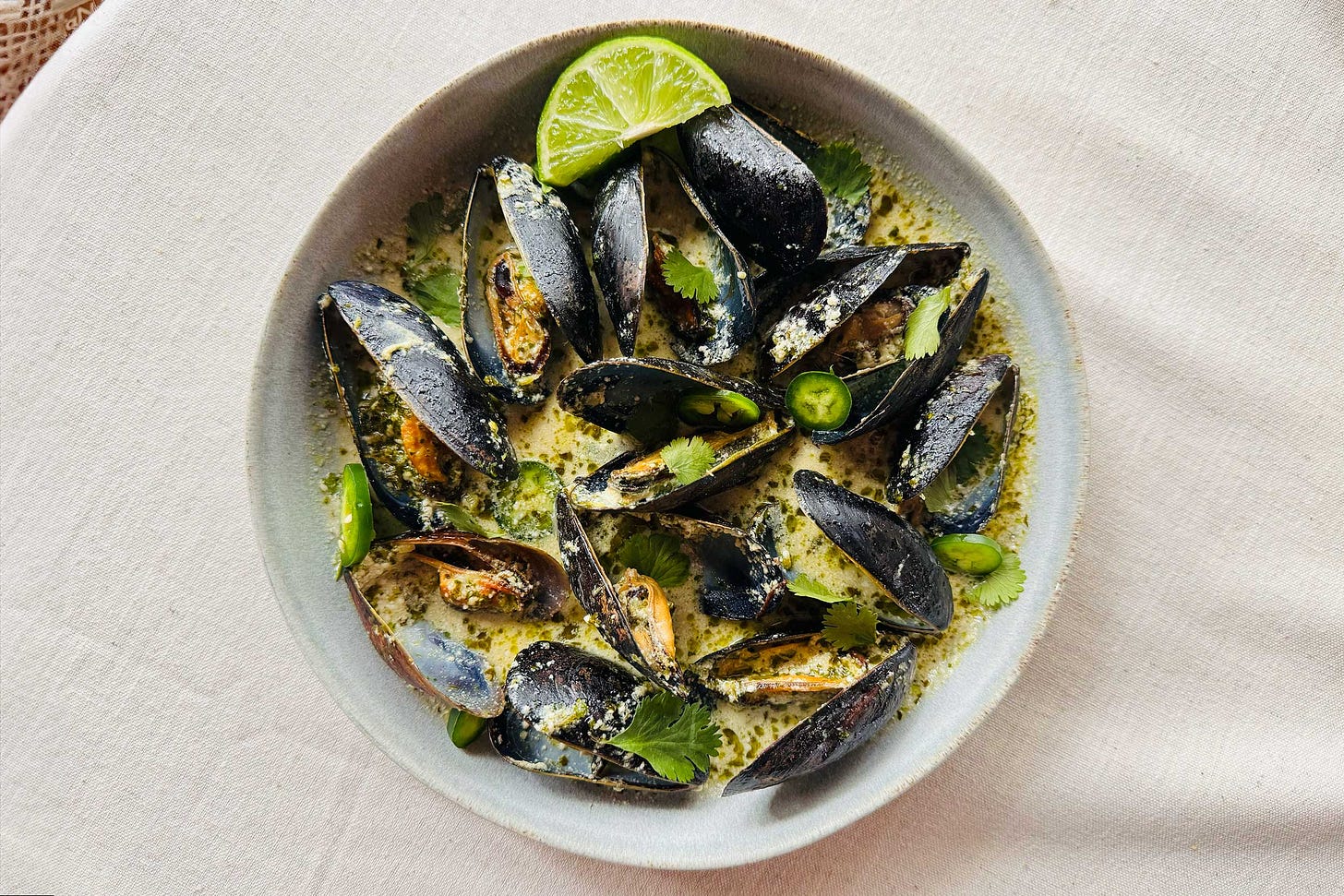The sustainable seafood superstar missing from your rotation
Meatless Mondays? How about Mussels Mondays?!
Hey there, and welcome to another edition of our back-to-basics series here at Cool Beans. Today we’re talking about mussels, a practically perfect protein. Gram for gram, these little sea gems are as protein dense as canned tuna, and they’re vastly more sustainable. Farming bivalves (that includes mussels, oysters, and clams) nets just a quarter of the greenhouse emissions as catching an equivalent amount of tuna, making them the lowest-footprint animal protein we know of. Mussels are also at the top of our list, because farming the filter feeders makes our oceans cleaner.
I get that a lot of folks are intimidated to make them at home, but I assure you it’s easier than you think. Mussels are quick-cooking, versatile, and, at two to three bucks a pound, pretty inexpensive. They’re perfect for parties but equally suited to fancy (but easy!) weeknight dinners. Today I’m doing a deep dive on how to clean, prep, and cook this protein MVP. Before you know it, you’ll be making moules frites on a casual Monday night.
The overview: A quick mussel training session
When it comes to cooking shellfish at home, the anxiety can run pretty high. The good news from both a saving-the-planet and I-don’t-want-to-fuss POV is that most of the mussels sold in stores are farmed. That means they have a footprint that’s around one-tenth that of wild-caught ones, and that they come pretty clean compared with grungier seafaring varieties.
Follow Cool Beans on Instagram for more tasty, Earth-friendly eats
When shopping for mussels as a main dish, aim for 1 pound per person (shells included); for an appetizer, halve that. If they’re in a mesh bag, place the bag in a bowl. If they’re in plastic, empty them into a bowl so they can breathe. In either instance, cover the bowl with a damp towel to retain moisture, and store it in the fridge for up to three days.
Here’s what you need to know about gettin’ ’em ready to cook:
Clean. Farmed mussels usually require just a rinse. If they look gunky, scrub them with the rough side of a sponge to remove any dirt or debris. Don’t worry about any barnacles clinging to the shell.
Screen. Be on the lookout for open shells. Mussels are alive when you bring them home, and an agape shell is a signal that it’s kicked—and is therefore inedible. If you see any open ones, lightly tap them against the side of your sink. They should respond by closing up. If they don’t, toss them.
Shave. Mussels sprout fibrous “beards” that they use to cling to rocks and such. You need to remove those strings before cooking. To do this, grab the beard and pull it toward the hinge of the shell while rocking the shell back and forth. You can also gently scrape it off with a knife.
When your mussels are ready to cook, you can simply steam them in some wine or beer until they pop open, sauce them up, toss them with pasta, or serve them in a flavorful broth for ladling over rice or soaking up with bread.
Most dishes take around 30 minutes—including prep work—which is exactly how long most rice cookers take to finish a batch of fresh grains. How convenient! Take, for example, Tyler Florence’s Thai-inspired mussels in coconut milk. The shellfish steam in a jacuzzi of lager until they just start to open; then an aromatic mix of garlic, Thai chiles, ginger, cilantro, lime zest, olive oil, and coconut milk join them in the pot. It all hangs out, covered, until every mussel’s open.
Check out the complete chile-infused mussels recipe at Food & Wine
I’m rarely without a can of coconut milk and a stash of frozen ginger and garlic, so this dish is absolutely going into my regular rotation. The broth is liquid gold: garlicky and gingery with a slight sweetness from the coconut and subtle heat from the chile. A ladle will completely transform a bowl of plain white rice. Florence describes it as the perfect party food, but for me it screams weeknight pick-me-up. Besides, I’ve got another go-to way to flex my mussels at the party—and it’s one you can make days ahead.
The recipe: These marinated mollusks are a dinner party go-to
One of my favorite ways to eat and enjoy mussels is to make an escabeche, a traditional Spanish tapa. Escabeche is a technique where meat, seafood, or veggies soak in a spiced vinegar after they are cooked. The acid tenderizes the meat—plus you get to eat the marinade, so it’s less wasteful than doing it beforehand.
Escabeche can be eaten on its own, but it practically begs to be spooned over something to soak up that delicious tangy-briny marinade. I like it over a crusty baguette or scooped up with potato chips—the way it’s served in Spain. You can bulk this dish up into a main by adding some cooked spaghetti. Growing up I ate escabeche on tostones (twice-fried plantains), which is still my preferred vehicle. Whatever your chosen carb, I like to take a cue from famed tapas Chef Alex Raij and add a smear of good mayonnaise.
Mussels Escabeche
Yield: 4 servings (or 8 as an appetizer)






